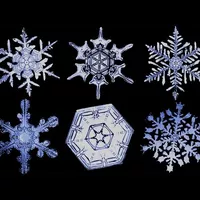The Science of Snowflakes
— You are a beautiful and unique snowflake.
— You are NOT a beautiful and unique snowflake.
— No on else is exactly like you, you're one in a billion.
— You realize that means there's like eight people exactly like you?
— Shut up!
— I am a unique snowflake.
That's so cheesy.
There's a lot of snowflake science videos out there on YouTube and they all mention the same idea that no two snowflakes are alike.
But where do we get that idea?
The universe is a big place.
It's really old, and on countless planets with countless snowflakes, surely two of them have been alike.
The idea that no two snowflakes are alike probably started on January 15, 1885 in Jericho, Vermont.
A twenty-year-old named Wilson Bentley was sitting outside his farmhouse, freezing his Bentleys off, holding a sheet of black fabric and a turkey feather in the other hand, waiting for a snowflake to fall in just the right spot.
And, when it did, he put that snowflake under a microscope attached to an enormous old camera.
And he held his breath [as] one wrong breath could ruin the whole thing.
He opened the shutter and POOF!
Wilson Bentley had the first photograph of a snowflake ever taken.
Wilson Bentley like SERIOUSLY loved snowflakes, in the sense that he never got married, never moved out of his mom's house, and basically just took pictures of snowflakes for like fifty years.
Now, he called them “masterpieces of design.”
Of course, we know there is no design in a snowflake, but that doesn't make them any less amazing.
Every plate, every branch, every needle on a needle on a needle, all of those details are what's called emergent properties.
This is complexity that's based on very simple rules.
And for snowflakes, those rules go back to the basic laws of physics.
In the air, or in liquid water molecules are zipping around, bouncing off of each other and everything else trillions of times per second.
We have no way of knowing where they are or what direction they are facing at any moment.
As we remove heat, it gets colder, and those water molecules start to slow down.
Eventually, their atomic attraction, the actual hydrogen bonds between water molecules, takes over, and they settle into order.
That sounds complicated, but we just call that "freezing".
The structure of a snowflake can be found in just six water molecules.
I know that the angle between any two hydrogens is about hundred and five degrees.
And I know that's true for any water molecule in the entire universe.
And for some of those water molecules, well, the other hydrogen's behind them.
Just like that, we've uncovered the six-fold symmetry of a snowflake crystal.
That crystal starts as a tiny speck of dust, or pollen, which catches water vapor out of the air and eventually forms the simplest of snowflake shapes: tiny hexagons called diamond dust.
And then, randomness takes over.
There's a very simple reason why a snowflake's arm grows out here and not here.
It's just because it sticks out farther and has a higher probability that water molecules will land there.
And more water molecules and more water molecules land, and then we've got an arm, and another arm, and another arm, and on and on, until we get the intricate and beautiful shapes that we know and love.
Depending on temperature and humidity, and a lot of factors that scientists don't even understand, those simple hexagons can give rise to seemingly infinite shapes.
Each snowflake will travel through different air currents and bump into different water molecules.
BUT . . .
In 1998, researcher Nancy Knight claimed to find two identical snowflakes, and they DO look very much alike.
It's quite possible that two of those simple hexagons could be the same in every measurement of size and mass, but they would NOT be identical, and physics tells us why.
We know that water molecules are made of two hydrogen atoms and an oxygen atom.
But not every hydrogen is created equal.
If we go back to the Big Bang, we find out that out of every million or so hydrogen atoms created, a couple hundred of them, instead of just being a proton and an electron, are holding on to a neutron.
This is the isotope of hydrogen called "deuterium".
In Earth's water, even in you, about one in three thousand molecules will be holding onto deuterium instead of hydrogen.
Out of the million million million molecules that make up a snowflake, a lot of them will holding on to deuterium too.
Even identical looking snowflakes are not the same.
Now you could love a snowflake just because it's pretty.
But it doesn't take away from its beauty to understand that it was sculpted by chance and physics.
To me, that adds to the beauty.
I have to say, this whole "we are unique snowflakes" thing is pretty cheesy.
It might be the most overused metaphor in the history of metaphors.
So, let me give you a new one:
Snowflakes are symmetrical, but they're not perfect.
They're ordered, but they're created in disorder.
Every random branch re-tells their history, that singular journey that they took to get here, and most of all they're fleeting and temporary.
Even if sometimes they don't look so unique on the outside, if we look within, we can see that they're truly unique after all.
Stay curious.
We're not the only social animals that sit down to eat together, but we are the only ones who cook.
Cultural anthropologist Claude Levi-Strauss says that above all cooking establishes the difference between animals and people.
We're gonna put a happy little arm over here.
Look at that happy little snowflake.
Everyone of 'em is unique and beautiful, just like you are.

